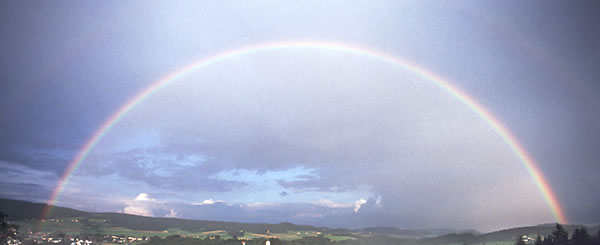
OpticsPOD
What's New
Rays & Shadows
Water Droplets
Rainbows
Not a rainbow!
Primary
Raindrop Rays
Rainbow Cone
Low & High Bows
Drop size
Colours
Secondary Bow
A's Dark Band
Other Orders
Supernumeraries
Red Bows
Rainbow Wheel
Dew Bow
Sea Spray Bow
Glass Bead Bows
Reflection Bows
Twinned Bows
Cloud Bows
Moon Bows
Image Gallery
Simulators
Ice Halos
High Atmosphere
Links & Resources
Search - Index
123456789012345678
| Primary Rainbow |
|
Bright primary rainbow over Schlägl, Austria. The sky is brighter inside the bow because rainbows are disks of light rather than sets of coloured rings. Outside the primary there is a fainter secondary bow. Imaged by Karl Kaiser (site) on August 28, 2002. ©2002 Karl Kaiser, shown with permission. |
|||||||||
| To
see a rainbow we need sunshine and falling rain. Rainbows are rarer
than might be thought. In any one place in rainy England there
are fewer than ten bright ones in a year. Halos occur
much more frequently. Early morning and late afternoon are the best times to see them because the sun must not be too high. Rainbows are always opposite the sun and their centres are below the horizon at the the antisolar point. The lower the sun the higher is the bow. Red is always outermost in the primary bow with orange, yellow, green and blue within. Occasionally, when the raindrops are small, fainter supernumerary arcs of electric greens, pinks and purples lie just inside the main bow. A rainbow is not just a set of coloured rings. The sky inside is bright because raindrops direct light there too. The primary bow is a shining disk brightening very strongly towards its rim. |


